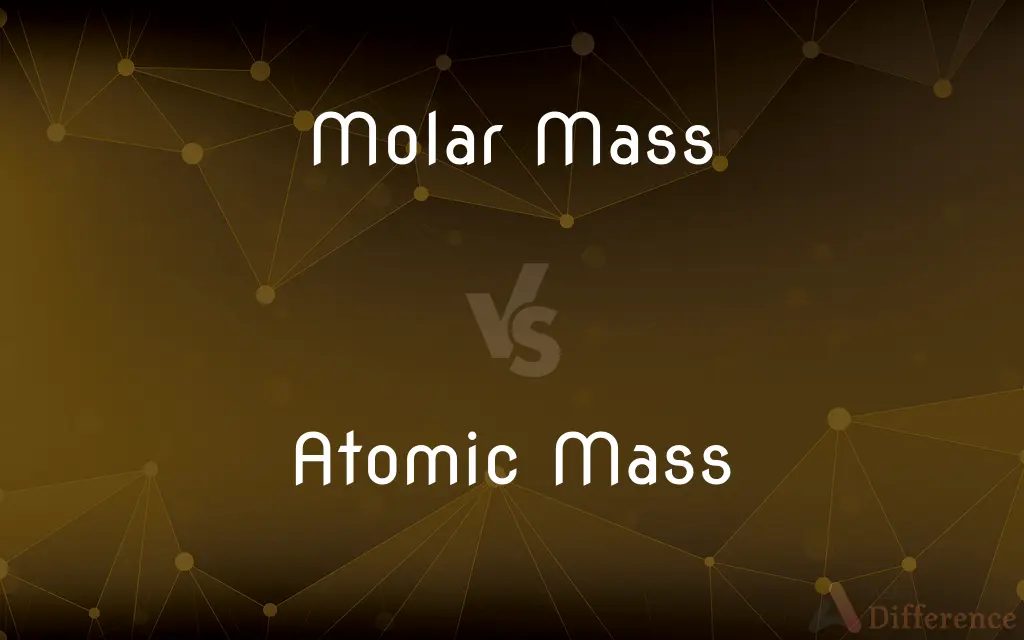Molar Mass vs. Atomic Mass — What's the Difference?
Edited by Tayyaba Rehman — By Fiza Rafique — Published on January 10, 2024
Molar Mass is a mass of one mole of a substance (g/mol). Atomic Mass is a mass of a single atom, usually in atomic mass units (amu).

Difference Between Molar Mass and Atomic Mass
Table of Contents
ADVERTISEMENT
Key Differences
Molar mass is a measure of the mass of one mole of a substance, typically expressed in grams per mole (g/mol). It accounts for the mass of all atoms in a molecule.
Atomic mass, on the other hand, refers to the mass of a single atom. It's usually expressed in atomic mass units (amu) and represents the average mass of all isotopes of an element.
To calculate the molar mass of a compound, one adds the atomic masses of all the atoms in the molecule. This value is essential in chemical calculations, particularly in stoichiometry.
Atomic mass is a fundamental property of elements, found on the periodic table. It plays a key role in understanding the relative mass of different elements.
Molar mass allows chemists to convert between mass and moles of a substance, facilitating quantitative analysis in chemical reactions.
ADVERTISEMENT
Atomic mass, being specific to individual atoms, helps in understanding the structure and properties of elements and their isotopes.
Comparison Chart
Definition
Mass of one mole of a substance.
Mass of a single atom.
Units
Typically grams per mole (g/mol).
Atomic mass units (amu) or daltons.
Application
Used to calculate mass of compounds.
Used to understand individual atom's mass.
Calculation
Sum of atomic masses in a molecule.
Average of isotopic masses.
Relevance in Chemistry
Essential for stoichiometry.
Fundamental in understanding element's nature.
Compare with Definitions
Molar Mass
Mass per mole of molecules or atoms.
To find the mass of 2 moles of CO₂, multiply its molar mass by 2.
Atomic Mass
Mass of a single atom, typically in amu.
The atomic mass of carbon is approximately 12 amu.
Molar Mass
The mass of one mole of a substance.
The molar mass of water (H₂O) is approximately 18 g/mol.
Atomic Mass
A fundamental property listed on the periodic table.
By looking at the periodic table, you can find the atomic mass of any element.
Molar Mass
A measure used in stoichiometric calculations.
By knowing the molar mass of a reactant, you can calculate how much product will form.
Atomic Mass
Weight of an atom based on its isotopes' masses.
Chlorine's atomic mass is about 35.45, reflecting its isotopic composition.
Molar Mass
Sum of atomic masses in a compound per mole.
The molar mass of sodium chloride (NaCl) is about 58.44 g/mol.
Atomic Mass
A measure of an atom's mass relative to carbon-12.
Hydrogen's atomic mass is about 1, making it the lightest element.
Molar Mass
Weight of a mole of particles, atoms, or ions.
The molar mass of oxygen gas (O₂) is approximately 32 g/mol.
Atomic Mass
The average mass of atoms of an element.
Because of its isotopes, the atomic mass of copper is about 63.55 amu.
Common Curiosities
Why is molar mass important in chemistry?
Molar mass is important for stoichiometric calculations and converting between mass and moles.
What is molar mass?
Molar mass is the mass of one mole of a substance, expressed in grams per mole.
What does atomic mass represent?
Atomic mass represents the mass of a single atom, usually in atomic mass units (amu).
How is molar mass calculated?
Molar mass is calculated by adding the atomic masses of all atoms in a molecule.
Can molar mass be used for elements and compounds?
Yes, molar mass can be used for both elements and compounds.
Does atomic mass vary with isotopic composition?
Yes, atomic mass varies based on the relative abundance of an element's isotopes.
Is atomic mass constant for an element?
Atomic mass is relatively constant for an element, reflecting its isotopic composition.
Can atomic mass be fractional?
Yes, atomic mass can be fractional due to averaging the masses of isotopes.
What is the unit for atomic mass?
The unit for atomic mass is atomic mass units (amu) or daltons.
How do you find the atomic mass of an element?
Atomic mass is typically found on the periodic table, representing the average mass of an element's isotopes.
Can two different substances have the same molar mass?
Yes, different substances can have the same molar mass by coincidence.
Is atomic mass the same for all isotopes of an element?
No, different isotopes of an element have different atomic masses.
Is molar mass always a whole number?
No, molar mass is not always a whole number due to the addition of atomic masses in a compound.
Is molar mass specific to chemical compounds?
Yes, molar mass is specific to each chemical compound based on its atomic composition.
How is molar mass used in reactions?
Molar mass is used to calculate the amounts of reactants and products in chemical reactions.
Share Your Discovery

Previous Comparison
Guided Media vs. Unguided Media
Next Comparison
PLA vs. PALAuthor Spotlight
Written by
Fiza RafiqueFiza Rafique is a skilled content writer at AskDifference.com, where she meticulously refines and enhances written pieces. Drawing from her vast editorial expertise, Fiza ensures clarity, accuracy, and precision in every article. Passionate about language, she continually seeks to elevate the quality of content for readers worldwide.
Edited by
Tayyaba RehmanTayyaba Rehman is a distinguished writer, currently serving as a primary contributor to askdifference.com. As a researcher in semantics and etymology, Tayyaba's passion for the complexity of languages and their distinctions has found a perfect home on the platform. Tayyaba delves into the intricacies of language, distinguishing between commonly confused words and phrases, thereby providing clarity for readers worldwide.











































